AMD Kaveri APU Launch Details: Desktop, January 14th
by Ryan Smith on November 11, 2013 9:33 PM EST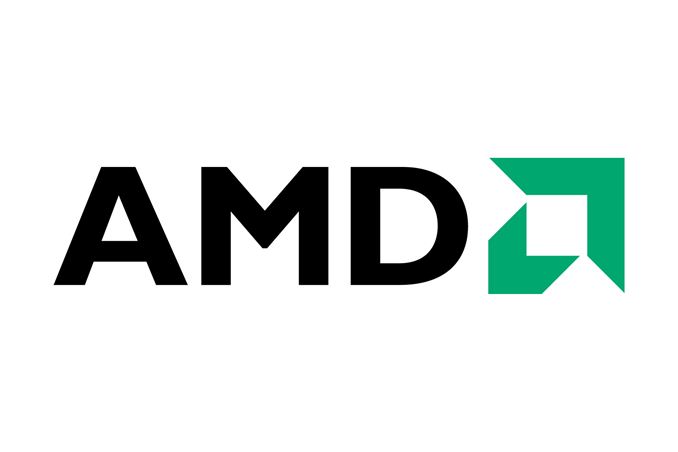
Kicking off today is AMD’s annual developer conference, which now goes by the name APU13. There will be several APU/CPU related announcements coming out of the show this week, but we’ll start with what’s likely to be the most interesting for our regular readers: the launch date for AMD’s Kaveri APU.
First and foremost, AMD has confirmed that Kaveri will be shipping in Q4’13, with a launch/availability date of January 14th, 2014. For those of you keeping track of your calendars, this is the week after CES 2014, with AMD promising further details on the Kaveri launch for CES.
Second of all, we have confirmation on what the highest shipping APU configuration will be. Kaveri will have up to 4 CPU core (2 modules), which will be based on AMD’s latest revision of their desktop CPU architecture, Steamroller. Meanwhile the GPU will be composed of 8 GCN 1.1 CUs, which would put the SP count at 512 SPs (this would be equivalent to today's desktop Radeon HD 7750). Furthermore AMD is throwing around a floating point performance number – 856 GFLOPS – which thanks to some details found in AMD's footnotes by PCWorld gives us specific clockspeeds and even a product name. A10-7850K CPU clockspeed 3.7GHz, GPU clockspeed 720MHz.
Third, in a departure from how AMD launched Trinity and Richland, Kaveri will be coming to the desktop first. The January 14th date is for the availability of desktop socket FM2+ Kaveri APUs, with server and mobile APUs to follow (these are presumably some of the CES details to come). Pricing and specific SKUs will of course be announced at a later time, and there wasn’t any clarification on whether this was just for OEM hardware, or if we’ll be seeing retail CPUs too.
Finally, AMD has confirmed on the GPU side that Kaveri will be shooting for feature parity with AMD’s latest discrete GPUs, by supporting many of the same features. Specifically, TrueAudio will be making an appearance on Kaveri, bringing AMD’s dedicated audio processing block to their APUs as well as their GPUs. On the discrete GPUs this is a move that was mostly about functionality, but on Kaveri it should take on a second role due to the fact that it’s exactly the kind of CPU-constrained environment for which having dedicated hardware will be a boon. Furthermore, AMD has also confirmed that their new low-level API, Mantle, will also be supported on Kaveri – it is after all a GCN based GPU.
For AMD Kaveri is going to be a big deal; likely the biggest CPU/APU launch for the company in quite some time. Since the acquisition of ATI all the way back in 2006 this is what the company has been building up to: producing a processor with a highly integrated CPU/GPU that allows both of them to be leveraged nearly-transparently by software. Kaveri is the launch vehicle for HSA both as a specific standard and as a general concept for a PC CPU/APU, so it’s something that everyone inside and outside of AMD will be watching closely.


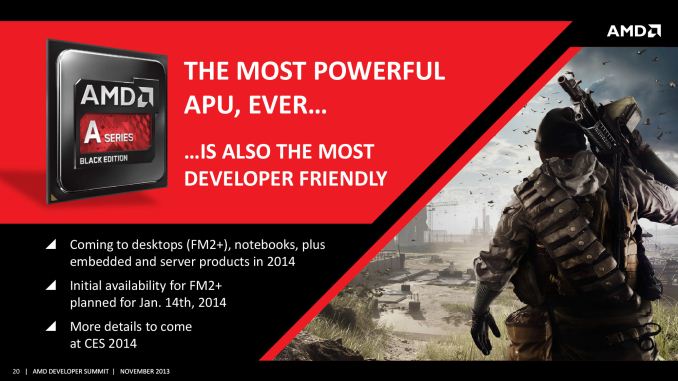
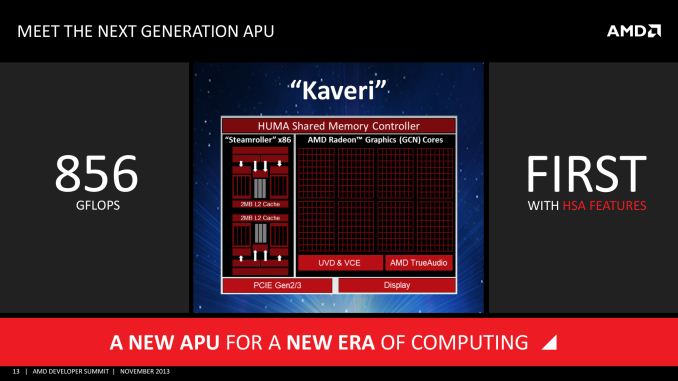
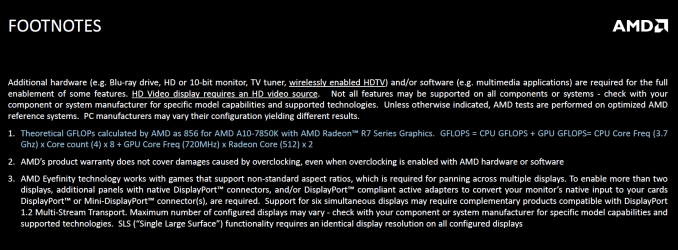

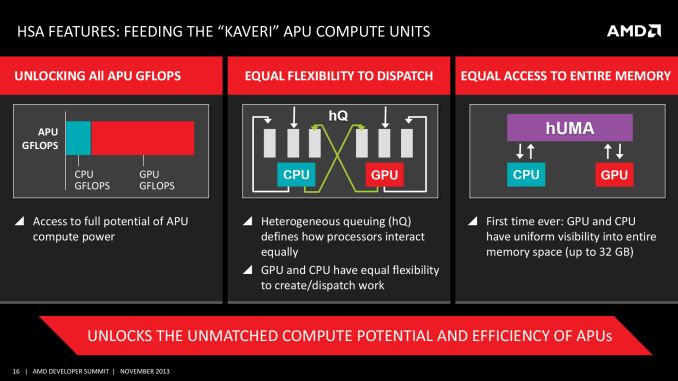








97 Comments
View All Comments
dylan522p - Wednesday, November 13, 2013 - link
Its only 300 because Intel can sell it for 300. The only difference between a $150 i5 and a i7 is all artificial (hyperthreading and depending on the skus, unlicked multiplier). The problem is that Intel's graphics are more efficient and have far less die space dedicated to them and their CPUs blow AMDs out the water.JDG1980 - Monday, November 11, 2013 - link
Assuming that PCWorld is correct, the clock speed regression is worrying: going back from 4.1 GHz to 3.7 GHz could wipe out a sizable portion of the IPC gains in lightly-threaded workloads. At least these APUs should perform more like a true quad-core chip due to the reduction of the CMT penalty.The server market is going to want a CPU-only product with more cores, at least six or eight. So are enthusiasts. Kaveri is a good mainstream product, but if AMD wants to get back high-margin business, it won't be enough on its own. It would make sense to unify both servers and high-end desktops on a single socket, like Intel did with LGA 2011; the existing AM3+ platform is getting a bit long in the tooth.
gonchuki - Tuesday, November 12, 2013 - link
Efficiency vs Brute Force. Intel scaled back from 3.4-ish ghz on the P4 to a mere 2.66 ghz on the Core 2 and they still won a huge performance increase, in a time where all loads were lightly threaded.Also agree with the AM3+ sentiment, they will definitely need at least a new chipset to get PCIe 3.0 support since their new GPUs in crossfire are now directly taxing the bus bandwidth.
extide - Tuesday, November 12, 2013 - link
That is totally not a valid comparison. Yes, intel went to lower clock speed in the Core 2 vs the P4, but that is also talking about two totally different architectures, two totally different products. Here they are just talking about one product, one architecture, and a 3-400Mhz reduction in clock speed. Not even close to the same thing.Xcause - Monday, November 11, 2013 - link
stolen from PS4... f***k you amd, logical sense, nvidia and intel FTW!Drumsticks - Tuesday, November 12, 2013 - link
You realize AMD makes the CPU and GPU in the playstation four and the Xbox one... Right...Gigaplex - Tuesday, November 12, 2013 - link
Uh... what?SunLord - Tuesday, November 12, 2013 - link
It's a special child don't stare to much its not politepiroroadkill - Tuesday, November 12, 2013 - link
If it wasn't so stupid, it would almost be funny. No, it would just be tragic.How on earth is it stolen? Also, the GPU mentioned is still way less powerful than the PS4 one.
The CPU architecture is also totally different. One and PS4 just have a bunch of shitty Jaguar cores.
silverblue - Tuesday, November 12, 2013 - link
Eight K8-style cores will be fine if the workload is divvied out relatively well. Sony reckons the CPU is ten times faster than that of the PS3, but in the end, if so many tasks are being offloaded to dedicated sound and graphics hardware, I doubt it'll be a problem using those eight cores to balance out the remaining workload.